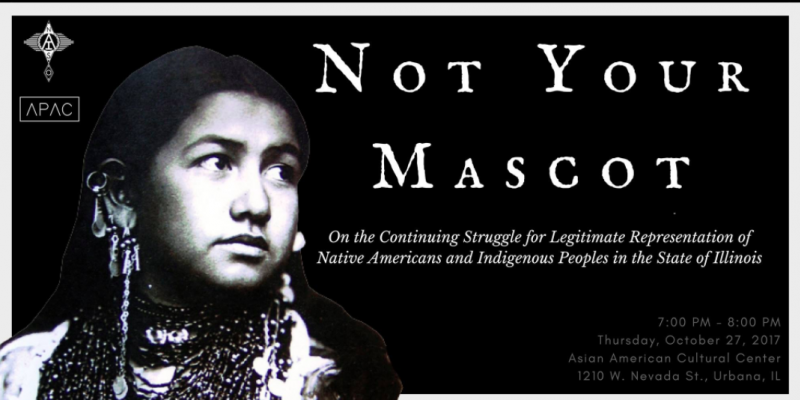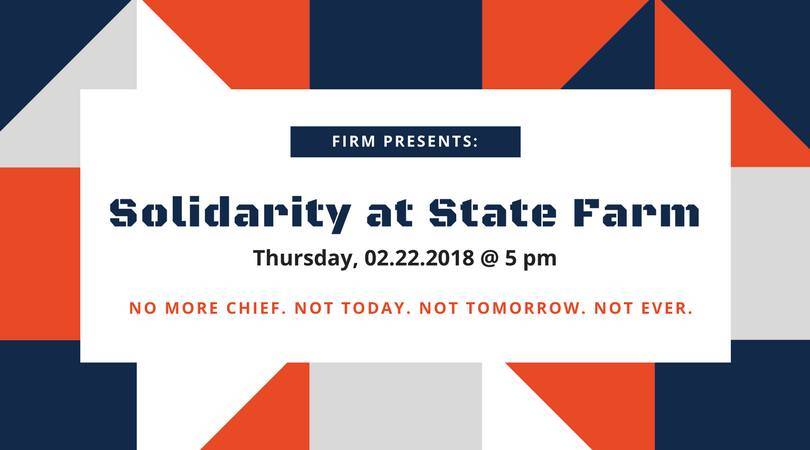At last count (Fall 2017), there are 47,826 students enrolled at the University of Illinois Urbana-Champaign. Of those students, 2,499 are African American, that’s 5.2%. The percentage of black residents in Illinois is 14.7%. There are only 25 Native American students enrolled at the University — that’s 0.05%. Statewide the Native American population is .6%. There are 20,778 white students, 43.44% of the population; statewide its 77.2%. To put it another way: All of the black students at the University will fit in Foellinger Auditorium (with a seat to spare!). All of the Native American students will fit in one classroom. Of 2,663 faculty, 118 are black, and 7 are Native American (that’s 4.4% and 0.26%, respectively); 1,802 are white (67.7%).
Representation matters. How we create meaning and value around others and ourselves is shaped by the representations and stories we share, and those we inherit. If you do not see yourself reflected in other students, in faculty and staff, and if the only way you see your heritage, your history, your future, is in the symbol of a white man in an outfit that falsely points to a spiritual ceremony, how could you possibly be in a position to succeed?
In 2005, the National Collegiate Athletic Association determined that the University of Illinois’ Chief Illiniwek mascot was hostile and abusive. (Yes, Chief Illiniwek was a mascot. Mascot, noun: an animal, person, or thing adopted by a group as its representative symbol and supposed to bring good luck.) Two years later, in 2007, the University of Illinois retired the mascot in all official capacities. We won’t recount the specifics of the history of the Chief and his retirement in this article. That history is well documented. We also won’t explain how and why the Chief is a racist caricature of Native Americans; that, too, is well documented.

Instead, let us consider how, eleven years removed from the “retirement,” the University and the surrounding communities are still embattled in this Chief-no Chief controversy. What is the University’s responsibility? Is there an opportunity to engage with this history and make amends?
The use of the term “retirement” is obviously purposeful: the University has washed its hands of the hostile and abusive imagery, making them clean to accept sponsorship, funding, and financial opportunity from the NCAA. The failure to replace the Chief with a new mascot and make active attempts to start a new chapter in the school’s history has left a vacuum, which has been filled by some alumni and fans who feel that in “retiring” the Chief, their memories and identities are being erased.
The University’s official policy is that the Chief is no more, and yet actions suggest otherwise. Consider the music played at sporting events (also recently “retired”). Consider that the Honor the Chief Society, a group dedicated to reviving the hostile and abusive mascot, was included in the University’s 2017 Homecoming Parade. Consider all of the “unofficial” appearances of the Chief at University events (including athletic events). The gross inconsistencies in the words and actions of the University function as a wink and a nod to Chief enthusiasts hell-bent on reviving the former mascot.
To these criticisms the University states, “These are First Amendment issues. This is about free speech. We can’t do anything.” Of course, no University official — administration, police officer, faculty — can actually do anything about the student who shows up to an event wearing a feathered headdress and the former mascot on his t-shirt. Those types of expressions are indeed protected by the First Amendment. But because the University has cultivated a culture of complicity, these individuals and groups feel empowered to continue to behave in these ways. The University has positioned itself comfortably in the small space between having done something (retiring the Chief) and not being legally liable for the harm this open wound continues to cause. In doing so, it further weakens the possibility of building healthy relationships with historically marginalized people on campus. The status quo is not working. Something has to change.
Change is slow, and it requires leadership. The University has been negligent in this regard, yet it touts its commitment to being a pre-eminent institution,
… recognized by our peers as leaders. We will be visible to the nation and world – this is the leadership expected from a world-class university with a land-grant mission.
In some ways, the University has achieved this pre-eminence, in that it sure is visible to the nation and the world, as news organizations are telling the story:
- An Indian ‘Chief’ Mascot Was Dropped. A Decade Later, He’s Still Lurking.
- U. of Illinois’ Chief Illiniwek mascot lives on at school despite ban
- More than a mascot
- Bernstein: University Of Illinois’ ‘Chief’ Saga Gets Even Dumber
- Illinois seeks new mascot 9 years after Chief Illiniwek’s removal
Consider what has happened to the American Indian Studies program: gutted. Defunded. Consider the fact that Champaign-Urbana is an island in a sea of sundown towns. Consider the Native American House: a staff of three (plus four student workers); it was not founded until 2002, and has been physically and institutionally relocated multiple times in its short history. And yet, the Native American House community continues to tell its story, to amplify others’ stories in an attempt to prevent erasure.
Now, the University has an opportunity to be a leader among its peers in actively recruiting and retaining historically marginalized students, faculty, and staff. It has an opportunity to tell a different story: one of inclusion, of looking forward instead of backwards, of making changes to benefit those who have historically been oppressed and silenced. But in order to attract and retain these students, there needs to be representation. Campus is not welcoming when the only representation of Illinois’ Native American history is a caricature of the noble savage, happily dancing a “fancy dance” for the University community and fans, and acting as their avatar leading them into “battle” against their rival team. There are more stories to tell.
Why write about this now, yet again? “Paint the Hall Chief” at tonight’s basketball game, which encourages people to wear and display images of the hostile and abusive mascot, feels like a tipping point. This is an opportunity for the University of Illinois at Urbana-Champaign to consider the story being told, the history being recorded, the future being proposed. Could it be the time the University finally joins other institutions that have replaced their former racist mascots? The counter protest — Solidarity at State Farm — organized by the group Fighting Illinois’ Racist Mascots, is at 5 p.m. today at the State Farm Center.

Top photo from the University of Illinois at Urbana-Champaign Facebook page; Not Your Mascot photo from the Native American House Facebook page.
Smile Politely’s Editorial Board is Jessica Hammie, Julie McClure, Patrick Singer, and Seth Fein.








